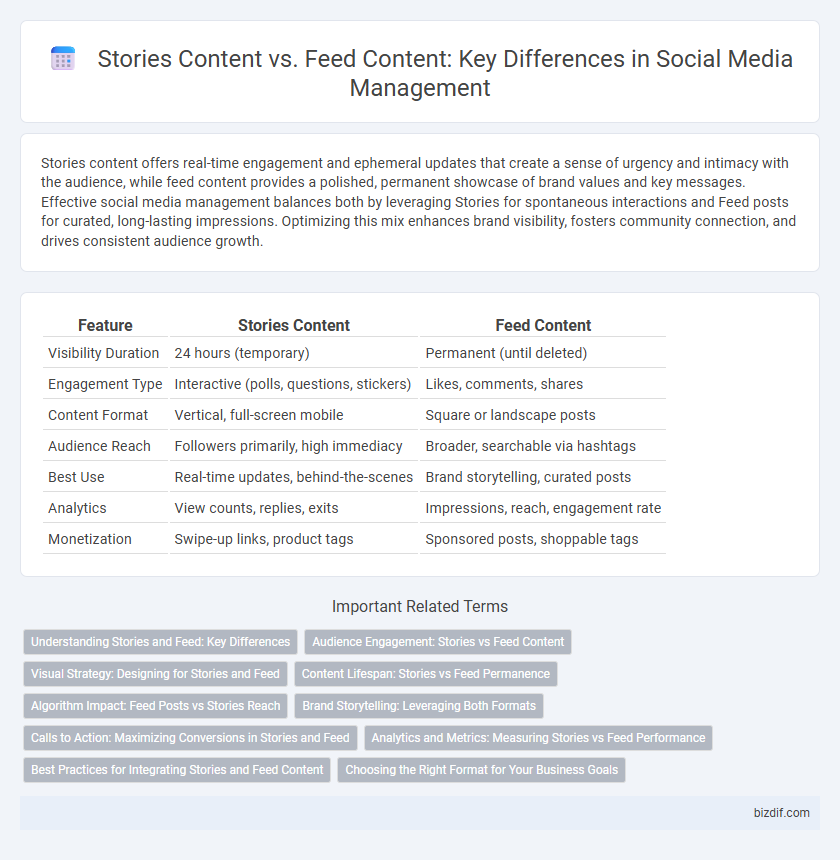Stories content offers real-time engagement and ephemeral updates that create a sense of urgency and intimacy with the audience, while feed content provides a polished, permanent showcase of brand values and key messages. Effective social media management balances both by leveraging Stories for spontaneous interactions and Feed posts for curated, long-lasting impressions. Optimizing this mix enhances brand visibility, fosters community connection, and drives consistent audience growth.
Table of Comparison
| Feature | Stories Content | Feed Content |
|---|---|---|
| Visibility Duration | 24 hours (temporary) | Permanent (until deleted) |
| Engagement Type | Interactive (polls, questions, stickers) | Likes, comments, shares |
| Content Format | Vertical, full-screen mobile | Square or landscape posts |
| Audience Reach | Followers primarily, high immediacy | Broader, searchable via hashtags |
| Best Use | Real-time updates, behind-the-scenes | Brand storytelling, curated posts |
| Analytics | View counts, replies, exits | Impressions, reach, engagement rate |
| Monetization | Swipe-up links, product tags | Sponsored posts, shoppable tags |
Understanding Stories and Feed: Key Differences
Stories content on social media is ephemeral, lasting only 24 hours, which encourages real-time engagement and spontaneous sharing, while Feed content remains permanently visible, allowing for polished, curated posts aimed at long-term brand identity and discoverability. Stories often utilize interactive features like polls, stickers, and links to boost direct audience interaction, whereas Feed content focuses on high-quality visuals and captions to build lasting impressions and support SEO strategies. Understanding these differences enables marketers to tailor their content effectively, optimizing reach and engagement across platforms like Instagram and Facebook.
Audience Engagement: Stories vs Feed Content
Stories generate higher audience engagement with their immersive, time-sensitive format that encourages real-time interaction through polls, quizzes, and swipe-ups. Feed content provides lasting visibility and allows detailed storytelling, which builds brand authority and nurtures audience loyalty over time. Leveraging a balanced strategy between ephemeral Stories and permanent Feed posts maximizes reach and sustained engagement for social media management.
Visual Strategy: Designing for Stories and Feed
Stories content requires vertical, full-screen visuals optimized for quick engagement and real-time updates, emphasizing bold, eye-catching graphics and interactive elements like polls or swipe-ups. Feed content benefits from polished, square or landscape images that maintain a cohesive aesthetic, encouraging longer user interaction through detailed captions and branded filters. Balancing these distinct visual strategies maximizes audience reach and reinforces brand identity across social media platforms.
Content Lifespan: Stories vs Feed Permanence
Stories content on social media offers ephemeral engagement, typically lasting 24 hours, creating urgency and encouraging real-time interaction. Feed content remains permanently visible, enhancing long-term brand presence and discoverability. Prioritizing Stories boosts immediate user engagement, while Feed posts build lasting audience connections and a comprehensive content archive.
Algorithm Impact: Feed Posts vs Stories Reach
Feed posts benefit from higher algorithmic ranking due to extended user engagement and deeper interaction metrics, resulting in greater organic reach compared to Stories. Stories generate ephemeral content impressions driven by sequential viewing but often lack the lasting visibility that boosts feed post performance. Prioritizing feed content can enhance long-term brand exposure, while Stories serve best for timely updates and real-time engagement spikes.
Brand Storytelling: Leveraging Both Formats
Stories content offers real-time, ephemeral engagement that fosters authentic connections and immediate audience interaction, while Feed content builds a permanent brand narrative through carefully curated visuals and messages. Combining Stories and Feed formats enhances brand storytelling by balancing spontaneity and consistency, maximizing reach and emotional resonance across social media platforms. Strategic use of both formats drives deeper audience retention and amplifies brand voice effectively.
Calls to Action: Maximizing Conversions in Stories and Feed
Stories content offers time-sensitive, interactive calls to action (CTAs) such as swipe-ups and polls, driving immediate engagement and conversions through urgency and exclusivity. Feed content supports more detailed CTAs like link clicks, comments, and saves, providing sustained discoverability and deeper user interaction over time. Leveraging the unique CTA strengths of both Stories and Feed maximizes conversion potential by combining instant user response with lasting content visibility.
Analytics and Metrics: Measuring Stories vs Feed Performance
Stories content typically generates high engagement rates with metrics like completion rate, tap forward, and exit rate providing insights into viewer interaction, while Feed content is measured primarily through likes, comments, shares, and overall reach. Analytics platforms reveal that Stories offer real-time performance data and ephemeral content impact, whereas Feed content metrics reflect longer-term audience engagement and content longevity. Comparing Stories and Feed performance helps optimize social media strategy by balancing immediate engagement with sustained visibility.
Best Practices for Integrating Stories and Feed Content
Maximize engagement by tailoring Stories content for real-time, behind-the-scenes moments that encourage direct interaction, while Feed content should showcase polished, evergreen posts that strengthen brand identity. Align visual themes and messaging across both formats to create a cohesive brand experience and utilize cross-promotion tactics, such as directing Feed followers to Stories for exclusive updates. Analyze performance metrics from Stories and Feed to refine content strategies, ensuring that each format complements the other and drives sustained audience growth.
Choosing the Right Format for Your Business Goals
Stories content offers ephemeral, engaging moments ideal for real-time promotions, behind-the-scenes glimpses, and fostering immediate audience interaction. Feed content provides a permanent, polished showcase for brand identity, product highlights, and long-term engagement through curated visuals and captions. Selecting the appropriate format depends on your business goals, whether driving instant engagement with Stories or building lasting brand presence through Feed posts.
Stories content vs Feed content Infographic

 bizdif.com
bizdif.com